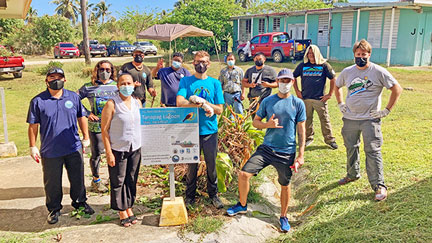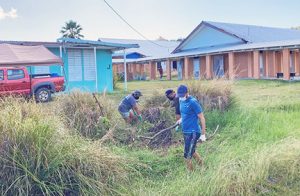Learning about the environment in schools
Rain garden restoration at Tanapag Middle School and Recycling in the Marianas winners

Tanapag Middle School principal Hilda Rios with staff from the Bureau of Environmental and Coastal Quality during the restoration of its Rain Garden Project. The school ’s rain garden is one of three that were installed by BECQ to demonstrate a form of best management practice to improve drainage on the island. The other schools are San Vicente Elementary School and William S. Reyes Elementary School. (Iva Maurin)
Schools are cradles for learning and values formation. With children spending most of their waking hours in schools, these educational institutions offer a structured avenue where young minds get molded and developed, hopefully, into becoming better citizens in the future.
Here in the CNMI, schools not only teach students their basic curriculum but also serve as partners, allies of government agencies, as well as non-government organizations, in helping children learn more about the environment. Schools also maintain environment projects—from tree-planting activities to recycling drives, to beach cleanups and coral restorations.
Tanapag Middle School, for one, has a Rain Garden Project, which they have been maintaining for about six years now, with the Bureau of Environmental and Coastal Quality, National Oceanic and Atmospheric Administration, and the Micronesia Islands Nature Alliance.
“The rain garden came about because the Tanapag area is a flood zone area. When it rains, and it rains hard, the water just gushes down from the mountainside into the school area and then into the village, right behind us,” Tanapag Middle School principal Hilda Rios said, in an interview with Saipan Tribune.
She added that what they wanted to do, and in conjunction with BECQ, was to start the project of a rain garden to help capture some of these runoffs so they do not go into the school, the village areas, and then into the ocean.
“[Rain gardens are] absolutely important in terms of protecting our waters. Our school is really just a few hundred feet away from the ocean, and we got to protect our biggest resource here—the waters that surround us. The rain garden does help with that tremendously, and our students have in the past.”
The school’s rain garden is one of four that the bureau installed and has been maintaining with its partners, with the other three in San Vicente Elementary School, William S. Reyes Elementary School, and the NMI Museum of History and Culture. The rain gardens demonstrate a form of best management practice (BMP) to improve drainage on the island.

The overgrown rain garden at the Tanapag Middle School is being cleared by staff of the Bureau of Environmental and Coastal Quality. The rain garden was installed to help capture runoffs from the mountains, when it rains, into the school zone area and then into the village area right behind the school. (Iva Maurin)
According to Division of Coastal Resources Management Watershed coordinator Zachary Williams, Saipan has a lot of impermeable spaces, areas where water cannot percolate or seep into the ground—such as roads, cement, sidewalks, rooftops, and buildings.
Because of these structures, water cannot get into the ground and recharge the aquifer. Especially in high slope areas, rain water also moves really fast on the ground and washes away sediments, causing sedimentation and erosion which impacts not just the land but also washes into the ocean.
“Rain gardens are a form of BMP to slow down water and help drain and sink water into the soil, so it improves [addresses] issues with erosion and surface water, potential flooding. It also helps recharge the aquifer by allowing that water to settle in,” Williams said.
He added that schools make a great place for a rain garden because not only does it help with drainage and habitat it also serves as an educational tool for students.
The rain garden at Tanapag Middle School is located on the school grounds, behind the Administrative Office, which students can easily see and learn from.
“The whole intention of the project is to help protect our oceans. For the most part, in the very beginning, the kids helped maintain the rain garden… They sometimes try to connect it to their lessons in the classroom, especially with science,” Rios shared.
“Our school has been very big in keeping the environment clean, helping our coastal areas. In addition to the rain garden, we have planted several mangrove trees, clean up the beaches. Our kids are big in the environment.”
Schools champion recycling
With trash a major problem in the CNMI, schools play a big role in helping educate and inform families, through students, on the proper way to manage solid wastes.
To celebrate Environmental Awareness Month, and to further increase student awareness and involvement in waste reduction and recycling, BECQ, with the Department of Public Works, sponsored the “Recycling in the Marianas” competition, where Marianas High School, Da’ok Academy, and Isla Montessori won.
Division of Environmental Quality environmental specialist Marlyn Naputi stressed that it is important for schools to be teaching kids about recycling.
“First, recycling is an overall beneficial process for the environment and we have to make sure they have a safe and clean environment for their future. What better way to make sure of that than by teaching them at a young age? Teaching students the process of recycling might change their view on how they look at their solid waste for the better.”

Tanapag Middle School principal Hilda Rios looks at the rain garden restored by the Bureau of Environmental and Coastal Quality last month. Rain gardens are planted in a depression meant to collect rainwater draining off roads, parking lots, or other areas where water could not soak into which flows downhill, picking up sediments that eventually end up in the ocean. (Iva Maurin)
The schools collected recyclable items such as cardboard/paper, aluminum cans, and plastic bottles, and delivered them to the DPW Recycling Center located at the Lower Base Transfer Station. DPW weighed and tracked each school’s recyclable materials management during the competition.
The winning schools were determined by the highest total weight collected per recyclable category. Marianas High School won the Cardboard/Paper category with 2,220 lbs. collected; Da’ok Academy won the Plastic Bottles category with 740 lbs.; and Isla Montessori won the Aluminum Cans category with 120 lbs. collected. The schools won $125.00 each.
Also winning through their achievements in waste reduction and recycling are these participating schools: Saipan Community School, Saipan International School, and Agape Christian School.
“School is an integral part of a child’s life and encouraging good habits at a young age can help a child carry on those good habits throughout life. Not only can they learn about it in school but also implement what they learn in the school environment.”
To learn more about rain gardens, contact Zachary Williams at zwilliams@dcrm.gov.mp or visit the CRM website at https://dcrm.gov.mp. For solid waste in schools, reach out to Marlyn Naputi at 664-8545 or marlyn.naputi@becq.gov.mp.























